This is the second session which will be as meaty as the first. The first speaker is Steven Starr, Associate of the Nuclear Age Peace Foundation, former board member and senior scientist for Physicians for Social Responsibility. He’s going to talk about Nuclear War: An Unrecognized Mass Extinction Event Waiting to Happen. Steven:
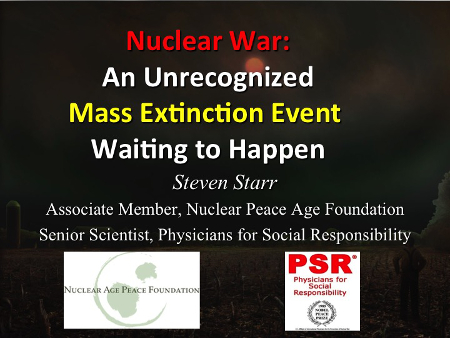
|
Thank you Helen.
In 1945, Albert Einstein said, “The release of atomic power has changed everything except our way of thinking.” In 2015, seventy years later, we are still stockpiling nuclear weapons in preparation for nuclear war. Our continued willingness to allow huge nuclear arsenals to exist clearly shows that we have not fundamentally grasped the most important truth of the nuclear age: that a nuclear war is not likely to be survived by the human species.
A war fought with 21st century strategic nuclear weapons would be more than just a great catastrophe in human history. If we allow it to happen, such a war would be a mass extinction event that ends human history. There is a profound difference between extinction and “an unprecedented disaster,” or even “the end of civilization,” because even after such an immense catastrophe, human life would go on.
But extinction, by definition, is an event of utter finality, and a nuclear war that could cause human extinction should really be considered as the ultimate criminal act. It certainly would be the crime to end all crimes.
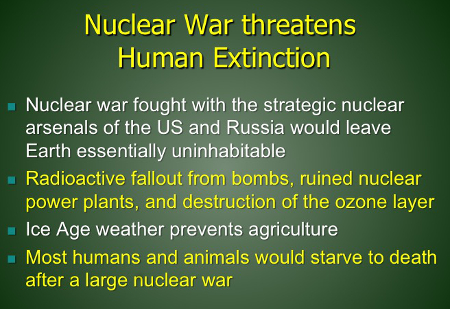
|
The world’s leading climatologists now tell us that nuclear war threatens our continued existence as a species. Their studies predict that a large nuclear war, especially one fought with strategic nuclear weapons, would create a post-war environment in which for many years it would be too cold and dark to even grow food. Their findings make it clear that not only humans, but most large animals and many other forms of complex life would likely vanish forever in a nuclear darkness of our own making.
The environmental consequences of nuclear war would attack the ecological support systems of life at every level. Radioactive fallout, produced not only by nuclear bombs, but also by the destruction of nuclear power plants and their spent fuel pools, would poison the biosphere. Millions of tons of smoke would act to destroy Earth’s protective ozone layer and block most sunlight from reaching Earth’s surface, creating Ice Age weather conditions that would last for decades.
Yet the political and military leaders who control nuclear weapons strictly avoid any direct public discussion of the consequences of nuclear war. They do so by arguing that nuclear weapons are not intended to be used, but only to deter.
Remarkably, the leaders of the Nuclear Weapon States have chosen to ignore the authoritative, long-standing scientific research done by the climatologists, research that predicts virtually any nuclear war, fought with even a fraction of the operational and deployed nuclear arsenals, will leave the Earth essentially uninhabitable.
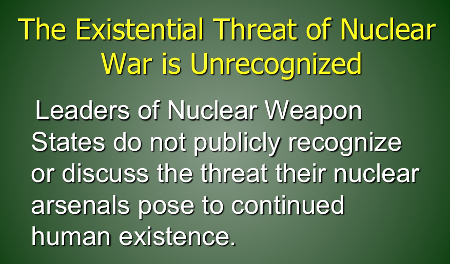
|
Some of the more recent of these scientific studies appeared in print almost 9 years ago. Yet their predictions have not been publicly acknowledged or discussed by any American or Russian President, nor by any of their top military leaders. In fact, none of the current leaders of any of the nations that possess nuclear weapons have ever made such a public acknowledgment.
It is not clear that these leaders are even aware of the findings of this research, since they have consistently refused to meet with the scientists who did the studies.
No Nuclear Weapon State has ever attempted to evaluate what consequences the detonation of their nuclear arsenals would have upon the global biosphere and ecosystems.

|
As a result, the grave threat to continued human existence posed by existing arsenals of nuclear weapons is a subject not included in the global debate on nuclear weapons.
The existential danger of nuclear war has not been mentioned during American presidential campaigns or debates for more than 40 years. Such considerations have never been included in any military planning or as part of any national strategic review of US military force requirements.
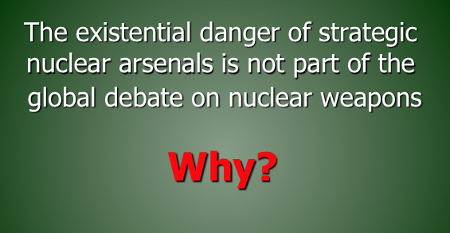
|
Why is this? According to our best scientists, the deployed arsenals of nuclear weapons pose a clear and present danger to the survival of our species. How is it that our leaders are unable or unwilling to even talk about this grave danger?
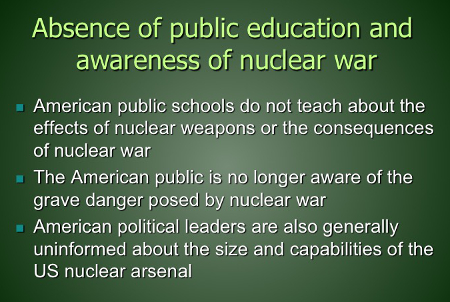
|
In the 1980s, the American public was generally aware of the existential threat posed by nuclear war. That awareness no longer exists today.
This is in part because US public schools do not teach students about nuclear weapons. A couple of generations of Americans have grown up with essentially no knowledge of the effects or consequences of nuclear war.
This may be why our political and military leaders continue to focus upon the numbers of nuclear weapons rather than the consequences of their use. This makes no sense when a single ballistic missile now carries almost three times more nuclear explosive power than all the bombs that were detonated during World War 2.
A universal ignorance of basic nuclear facts ultimately creates a very dangerous situation, because leaders who are unaware that nuclear war can end human history are likely to lack the gut fear of nuclear war that’s needed to prevent them from leading us into a nuclear holocaust.
I teach an online class on nuclear weapons at the University of Missouri [Nuclear Weapons: Environmental, Health and Social Effects], and I get smart students but virtually none of them that come into my class know anything about nuclear weapons; they don’t know the difference between an atomic bomb and a strategic nuclear weapon, they don’t know that large arsenals of strategic nuclear weapons even exist.
Without this basic knowledge, it is almost impossible for anyone to understand the immense dangers posed by nuclear war. Thus I am now going to take some time to explain these facts, to try to insure my message today is clear.
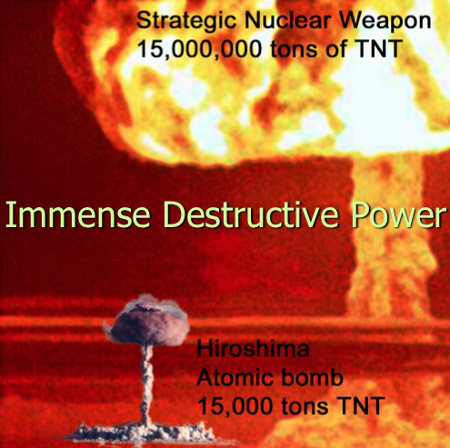
|
Atomic bombs were the first nuclear weapons to be invented. It was an atomic bomb that destroyed the Japanese city of Hiroshima at the end of the World War 2. A typical atomic bomb has an explosive power of about 15,000 tons of TNT, also called 15 kilotons. Atomic bombs are much less powerful than the hydrogen bombs, or thermonuclear weapons, which were invented in the 1950s. These “super-bombs” often had explosive powers one thousand times greater than atomic bombs.
The photo compares the relative size of the mushroom cloud produced by an atomic bomb to a mushroom cloud produced a thermonuclear weapon that had an explosive power of 15 million tons of TNT, which was tested by the United States in 1954.
Today, thermonuclear bombs are called “strategic nuclear weapons,” and they generally have an explosive power ranging from 100,000 tons to more than 1 million tons of TNT.
Of course, while an atomic bomb is much less powerful than a strategic bomb, it will still completely destroy any city.

|
This graphic illustrates the detonation of an atomic bomb above Midtown Manhattan, where we are now, in the heart of New York City. The solar temperatures of the bomb would almost instantly ignite a nuclear firestorm covering 3 to 5 square miles. It was an atomic bomb of this size—close to this size at least—that destroyed the city of Hiroshima in 1945.

|
It is shocking to see what the atomic bomb did to Hiroshima.
|
Images presented on Hiroshima:
the first city destroyed by a nuclear weapon
from Nuclear Darkness, Global Climate Change & Nuclear Famine – The Deadly Consequences of Nuclear War
CLICK AN IMAGE TO VIEW HI RES PANORAMA
|

Hiroshima
Peace Memorial Museum, Photo by Shigeo Hayashi - RA119-RA134
|

360 degree view span
Hiroshima
Peace Memorial Museum, Photo by H.J. Peterson - K-HJP001-K-HJP013
|

360 degree view span
Hiroshima
Peace Memorial Museum, Photo by Shigeo Hayashi A723-A742
|
More than 4 square miles of the city were utterly destroyed, transforming it into a barren wasteland.

|
(to see this detonation go from street level to covering
hundreds of square miles, go to
http://www.nucleardarkness.org/nuclear/nuclearexplosionsimulator/
and click “detonate”)
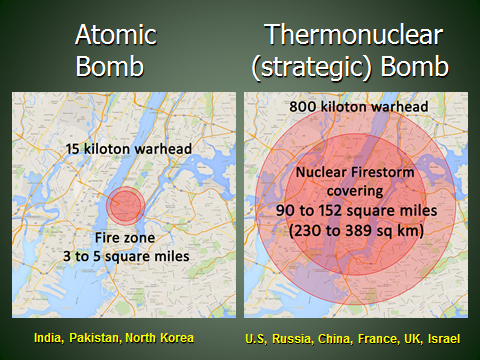
|
However, the firestorm produced by a strategic nuclear weapon is vastly larger than that produced by an atomic bomb. This graphic illustrates the most likely size of a fire zone, created by an 800 kiloton strategic nuclear warhead. This graphic shows it also being detonated above where we are now in New York.
by Steven Starr, Lynn Eden, Theodore A. Postol, Bulletin of the Atomic Scientist, February 25, 2015]
On an average day, the detonation of the warhead would instantly ignite fires over a total area of approximately 90 to 152 square miles. 20 to 30 minutes after the detonation, these fires would have joined together to form a single, immense firestorm.
Air temperatures in the fire zone would be above the boiling point of water. Hurricane force winds would blow towards the center of the firestorm, driving the flames horizontally, causing everything remotely flammable to burn. There would be no survivors in the fire zone.
Remember, 800 kilotons equals 800,000 tons of TNT. Russia has 1,000 strategic nuclear warheads that it can launch with less than 15 minutes warning, and 700 of these have an explosive power of 800 kilotons. In a war with the US, it would require about 30 minutes for these warheads to hit US cities.
Imagine a nuclear war in which hundreds or thousands of such firestorms were ignited in the course of less than one hour. There would be hundreds of cities, and hundreds of thousands of square miles, all burning at the same time.
That would probably be the one of the first consequences of a US-Russian nuclear war.

|
This is because about 93% of the nuclear weapons are owned by the US and Russia. This chart illustrates the relative size of the nuclear arsenals of the nuclear weapon states. Russia has about 8,000 intact nuclear weapons, the US has about 7,300 nuclear weapons. France comes next with 300 nuclear weapons, and all the other Nuclear Weapon States have fewer than that.
|
Additional Sources Provided by Steven Starr Regarding
Global Stockpiles of Nuclear Weapons
Hans M. Kristensen and Robert S. Norris:
Estimated Global Nuclear Warhead Inventories, 2014.
World
Nuclear Weapon Stockpile, Ploughshares Fund,
(accessed 07/20/15), Updated 23 June 2015
Status of World Nuclear Forces, Federation of American Scientists
“US
nuclear forces, 2015,” Hans M. Kristensen and Robert S. Norris,
Bulletin of the Atomic Scientists, 27 Feb 2015, doi: 10.1177/0096340215571913
“Russian
nuclear forces, 2015,” Hans M. Kristensen and Robert S. Norris,
Bulletin of the Atomic Scientists, 14 April 2015, doi: 10.1177/0096340215581363
So Many Exist Ready To
Be Used
The World’s Nuclear Warheads Count, August 2014 Created by the Nuclear Warheads Monitoring Team at the Research Center for Nuclear Weapons Abolition (RECNA), Nagasaki University
From
“Graphic:
The World’s Nuclear Missiles,”
by Andrew Barr and Richard Johnson, National Post Staff, 4 May 2012 |
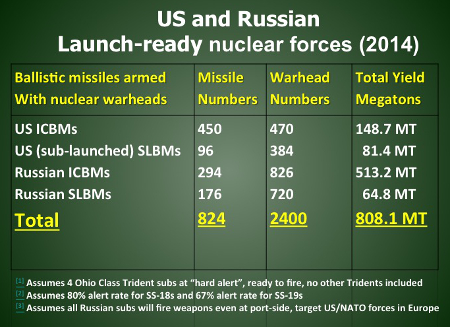
|
The US and Russia together maintain a total of more than 800 launch-ready ballistic missiles, which can be fired with less than 15 minutes warning, and will strike their targets in 30 minutes or less. Once they are launched, they cannot be recalled from flight. These missiles are armed with a total of about 2400 strategic nuclear warheads, which have a combined explosive power of approximately 808 million tons of TNT.
That’s a lot of TNT to visualize. The explosive power of 808 million tons of TNT is easier to visualize if you have something to compare it to.

|
The small red dot on the left side of this figure represents 2.7 million tons of TNT, which is estimated to be the total explosive power of all the bombs exploded by all the armies of the world during the 5 years of World War 2.
The large red circle represents the 808 million tons of TNT explosive power of US and Russian launch-ready nuclear weapons. This amount is 300 times greater than the explosive power of all the bombs exploded during World War 2. It would require less than one hour for these launch-ready weapons to all detonate over their targets.

|
In order to make sure that the US and Russian presidents can give the order to launch their missiles in less than one minute, both presidents are constantly accompanied by a military officer carrying a “nuclear briefcase”. The briefcase contains something similar to a laptop computer, which is designed to transmit the President’s order to launch a nuclear strike. The order goes to the military command centers where the actual launch would be carried out.

|
Another catastrophic consequence of nuclear war is likely to result from the targeting or destruction of nuclear power plants. [See above]
There are more than 400 commercial nuclear power plants in the world. 100 of them are in the United States, and about 285 are located in Europe and Eurasia. They hold some of the largest concentrations of radioactivity on the planet, and the largest portion of it resides in the used or spent fuel rods that are stored in spent fuel pools next to the reactors.

|
The rods in a fuel pool contain 5 to 7 times more radioactivity than is inside the nuclear reactor. However, these pools are all located outside the large concrete containment vessels that house the reactors. This means any catastrophic release of radioactivity from the pools will not be contained, but will be released into the atmosphere and the environment.
Spent fuel rods continue to produce huge amounts of heat even after they are removed from the reactor core. Thus spent fuel pools must constantly operate large cooling systems to remove this heat, otherwise the water in the pool will eventually overheat and boil-off.
This must be prevented at all costs because if the spent fuel rods are exposed to steam or air, they will rupture or ignite, and release huge quantities of radioactivity.
Even if spent fuel pools are not directly targeted in a nuclear war or during wartime, they would probably still be destroyed by the long-term loss of off-site electrical power, which is required to run their cooling systems.
In other words, the destruction of the electrical grid in a nuclear war would almost inevitably lead to the failure of spent fuel cooling systems, and the subsequent destruction of the spent fuel they contain. Ruptured or burning fuel rods would release huge amounts of radioactivity, including a radioactive isotope called cesium-137.
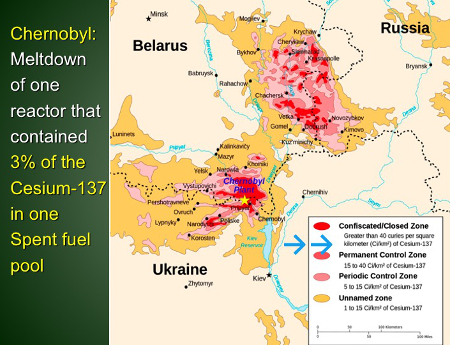
|
We unfortunately have had experience with what happens when cesium-137 is released by a catastrophic nuclear accident. The destruction of the Chernobyl reactor, which contained about 3% of the cesium-137 found in most spent fuel pools, created an uninhabitable radioactive exclusion zone, which covers more than 1100 square miles.
Looking at this map of the Chernobyl exclusion zone [hi resolution version], it specifies in the key that greater than 40 curies per square kilometer is required to make an area uninhabitable.
While I was studying this some years ago I remembered that cesium-137 has 88 curies per gram. So this means that in less than half a gram of cesium-137—if it’s made into smoke and spread over a square kilometer—it means you can’t live there for centuries. That translates into about 1.2 grams per square mile. An American dime weighs 2.7 grams. So you can take half the weight of a dime of cesium-137 and spread it over Central Park and nobody can live there again for centuries.
Many spent fuel pools each contain more than 1 million grams of cesium-137 within their spent fuel rods. A nuclear war would destroy hundreds of these fuel pools.
All this incredible destruction would lead to what scientists describe as a mass extinction event.

|
There is considerable evidence, which appears in the fossil records, that there have been 5 mass extinction events in geologic history. In these events, at least 50% of all animal species were wiped out. Afterwards, it took millions of years for animal life to recover to its previous levels of abundance.
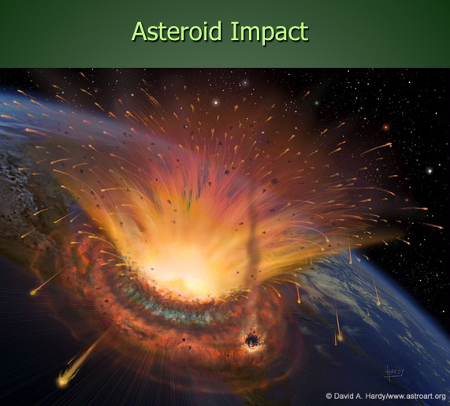
|
The most recent of these mass extinction events took place 66 million years ago, when an asteroid about 6 miles in diameter struck the Earth near the Yucatan peninsula. Its impact vaporized the Earth’s crust and it formed a 112 mile-wide crater in the Gulf of Mexico.
The super-heated material vaporized in the crater was blasted far above the Earth’s atmosphere. It then rained down upon the entire planet.

|
The debris from the asteroid heated Earth’s upper atmosphere to about 2700 degrees Fahrenheit, a temperature hot enough to melt steel. For a number of hours, the temperatures in the lower atmosphere climbed to about 700 degrees Fahrenheit and the dinosaurs were broiled alive.

|
At the same time, all the forests of the world caught fire and burned.
The smoke from the burning forests rose above cloud level into the stratosphere, where it surrounded and engulfed the Earth. The smoke formed a global stratospheric smoke layer, which remained in place for many years. I read that if you would have been there you could have held your hand in front of your face and you would not have seen it.
Because the smoke layer almost completely blocked warming sunlight, it created Ice Age weather conditions on Earth. This period of cold and dark that followed has come to be known as “Impact Winter”.

|

|

|

|

|

|
The Impact Winter devastated life on Earth. No land animal larger than a squirrel is believed to have survived the fire and ice from the asteroid. 75% of all the living species of plants and animals that had inhabited the Earth became extinct.
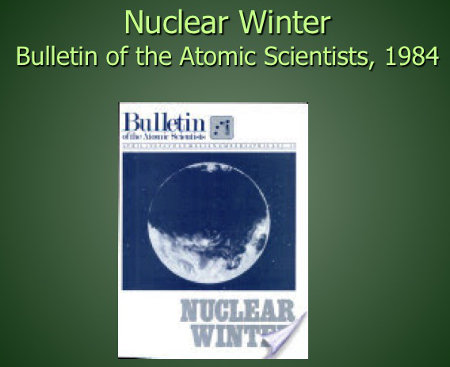
|
It was more than 30 years ago when scientists began warning that a nuclear war would also create a global stratospheric smoke layer, which would cause a “Nuclear Winter” similar to the Impact Winter.
New studies show that the original 1980s research actually underestimated the consequences of nuclear war.

|
Nuclear war and Nuclear Winter resemble the asteroid impact of Impact Winter in many basic ways. In a nuclear war, hundreds or thousands of nuclear detonations would ignite immense nuclear firestorms, which would produce as much as 150 to 180 million tons of smoke.
This smoke would rise above cloud level and encircle the Earth. Because the smoke could not be rained out, it would remain in the stratosphere for decades. There it would lead to the destruction of most of Earth’s protective ozone layer, while it would also block warming sunlight from reaching the surface of Earth.
Loss of the protective ozone layer would vastly increase the amount of harmful ultra violet (UV-B) light reaching Earth. The loss of warming sunlight would create weather conditions colder than those experienced at the height of the last Ice Age.
Temperatures would fall below freezing every day for one to three years in the continental interiors of North America and Eurasia. Growing seasons would be eliminated for at least a decade or longer. Nothing would grow, including the food crops we depend upon. Most humans and animals would starve to death.
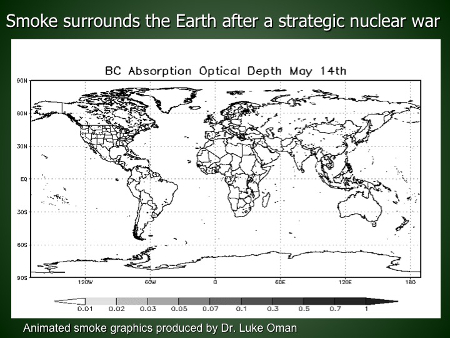
Please click on this graphic in order to see the animation
|
The animated graphic here was produced by Dr. Luke Oman, of NASA’s Goddard Space Flight Center, and it illustrates 150 million tons of smoke entering the stratosphere after a war fought with the strategic nuclear arsenals of the US and Russia. In less than 2 weeks, the smoke surrounds the earth. In a few more weeks, the smoke acts to block 70% of all sunlight reaching the surface of the Northern Hemisphere.
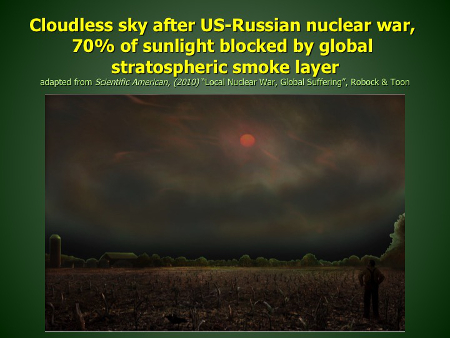
|
The illustration of a farmer standing in his ruined cornfield gives you some idea of how dark a cloudless sky in North America would appear following a war fought with strategic nuclear weapons. On a cloudy day at noon, the light levels would be similar to what we would experience now at midnight, during a full moon.
The image was adapted from an article published in 2009 by Scientific American, written by Drs. Toon and Robock, [Local Nuclear War, Global Suffering, Scientific American, 2009] a few years after they had published peer-reviewed studies that warned of the existential dangers of nuclear war.{+} In 2011, Dr. Robock wrote in Nature magazine that he had made multiple requests to meet with officials of the Obama administration, so that he and Dr. Toon could discuss the findings of their studies. All of his requests were denied.
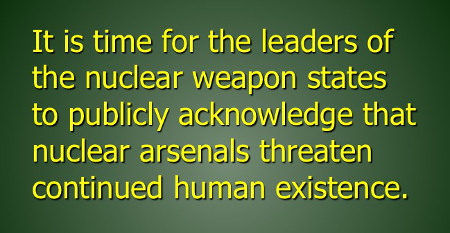
|
I could provide a lot more information and examples of leaders refusing to meet with scientists who only wish to warn them about the grave dangers posed by nuclear war. But further proof is unnecessary, simply because of the fact that none of the leaders of the nuclear weapon states have publicly acknowledged that a war fought with their nuclear arsenals could end human history.
It is time for them to do so.
It is also time for us to demand that they do so.
I began this talk with a quote by Albert Einstein, and I would like to close with another, one that we all should remember. Einstein said:
The world is a dangerous place to live; not because of the people who are evil, but because of the people who don’t do anything about it.
Don’t be one of them. Please, do whatever you can to help prevent nuclear war.
Thank you.
Biographical Sketch of Steven Starr (from PSR):
Steven Starr, MT (ASCP), graduated from the School of Health Professions at the University of Missouri, Columbia in 1985. He subsequently worked as a Medical Technologist over a period of 27 years at a number of hospitals in Columbia, Missouri, including Columbia Regional Hospital, Boone Hospital Center, and Ellis Fischel Cancer Center, as well as at Saint Mary’s Health Center, in Jefferson City, Missouri. Mr. Starr is currently the Director of the Clinical Laboratory Science Program at the University of Missouri.
Steven is an Associate member of the Nuclear Age Peace Foundation and has been published by the Bulletin of the Atomic Scientists. His writings appear on the websites of PSR, the Nuclear Age Peace Foundation, the Moscow Institute of Physics and Technology Center for Arms Control, Energy and Environmental Studies, Scientists for Global Responsibility, and the International Network of Scientists Against Proliferation. From 2007 through 2011, he worked with the governments of Switzerland, Chile, and New Zealand, in support of their efforts at the United Nations to eliminate thousands of high-alert, launch-ready nuclear weapons.
Mr. Starr is also an expert on the environmental consequences of nuclear war, and in 2011, he made an address to the U.N. First Committee describing the dangers that nuclear weapons and nuclear war poses to all nations and peoples. He has made presentations to Ministry Officials, Parliamentarians, Universities, citizens and students from around the world, and specializes in making technical scientific information understandable to all audiences.
Bibliography of Recently Published Works and Interviews:
- Turning a Blind Eye Towards Armageddon — U.S. Leaders Reject Nuclear Winter Studies, Federation of American Scientists / Global Research, 9 January 2017
- US Leaders Reject “Nuclear Winter” Studies, Ignore Existential Danger of Nuclear War. Turn a Blind Eye towards Armageddon, Global Research, 1 November 2016
- Nuclear War, Nuclear Winter, and Human Extinction, Federation of American Scientists, 14 October 2015
- Interview: Steven Starr on the overwhelming urgency of de-alerting U.S. & Russian missiles (59:00), If You Love This Planet with Helen Caldicott, M.D., 14 September 2015
- What would happen if an 800-kiloton nuclear warhead detonated above midtown Manhattan? with Lynn Eden & Theodore A. Postol, Bulletin of the Atomic Scientist, 25 February 2015
- One City, One Bomb, Slide Show with Theodore A. Postol, Bulletin of the Atomic Scientist, 25 February 2015
- “The Russian Aggression Prevention Act” (RAPA): A Direct Path to Nuclear War with Russia, Global Research, 22 August 2014
- Interview: Steven Starr Describes Nuclear Darkness and Nuclear Famine (40:18), The Corbett Report, 8 August 2014
- There Can be No Winners in a Nuclear War, Truthout, 11 June 2014
- The Lethality of Nuclear Weapons,
Paulcraigroberts.org, 30 May 2014; CounterCurrents.org – with additional embedded link references, 31 May 2014; Global Research, 5 June 2014- Ukraine + NATO = Nuclear War, Truthout, 11 March 2014
- The Implications of The Massive Contamination of Japan With Radioactive Cesium, Helen Caldicott Foundation Fukushima Symposium, New York Academy of Medicine, 11 March 2013
- Costs and Consequences of the Fukushima Daiichi Disaster, PSR - Environmental Health Policy Institute, 21 October 2012
- The Missile Crisis That Never Went Away, Starr S, Krieger D, Ellsberg D, Truthdig, 16 October 2012
- High Alert Nuclear Weapons - The Threat to All Nations and People, 2 September 2012
- “Pathways, Impacts, and Policies on Severe Aerosol Injections into the Atmosphere: 2011 Severe Atmospheric Aerosols Events Conference,” Martin Weil, Hartmut Grassl, Gholamali Hoshyaripour, Silvia Kloster, Jasmin Kominek, Stergios Misios, Juergen Scheffran, Steven Starr, Georgiy Stenchikov, Natalia Sudarchikova, Claudia Timmreck, Dan Zhang, Martin Kalinowski, Bulletin of the American Meteorological Society, Volume 93, Issue 9, September 2012
- NATO and U.S. Missile Defense in Europe are a Serious Political Concern, Nuclear Age Peace Foundation, 20 July 2012
- Will US Lack of Imagination Lead to Nuclear Nightmare? Truthout, 17 January 2012
- U.S. and Russian Launch-Ready Nuclear Weapons: A Threat to All Nations and Peoples, Nuclear Age Peace Foundation, 24 June 2011
- The Lessons of Fukushima and Chernobyl Briefing Book, Starr S, Patterson J, Helfand I, Kanter A, Rachow J, Physicians for Social Responsibility, 17 April 2011
- The Climatic Consequences of Nuclear War, Bulletin of the Atomic Scientist, 12 March 2010
- Deadly Climate Change from Nuclear War: A Threat to Human Existence, Strategic Arms Reduction website of the Moscow Institute of Physics and Technology, 27 December 2009 (Russian text)
- Nuclear Suicide, Australia Broadcasting Company (ABC) Unleashed website, 31 July 2009 (reproduced in this sciencealert.com link)
- High-Alert Nuclear Weapons: the Forgotten Danger, Scientists for Global Responsibility Newsletter, No. 36, Autumn 2008
- The Cold War Hasn't Ended: Nuclear Deterrence versus Nuclear Disarmament, Columbia Daily Tribune, 22 June 2008
- Catastrophic Climatic Consequences of Nuclear Conflict, Bulletin of the International Engineers and Scientists Against Nuclear Proliferation, Volume 28, April, 2008. Updated version published by the International Commission on Nuclear Non-Proliferation and Disarmament, December 2009.
- An Explanation of Nuclear Weapons Terminology, Nuclear Age Peace Foundation, December 2007 (local copy)
- “Nuclear Primacy” is a Fallacy, Valery Yarynich, Steven Starr, Intelligent.ru (Russian) 25 May 2006, Global Research, 4 March 2007
- Change Launch on Warning Policy, Phillips A, Starr S, Moscow Institute of Physics and Technology, The Center for Arms Control, Energy, and Environmental Studies, Strategic Arms Reductions (STAR), April 2006
- The Effects of a 300 kiloton Nuclear Warhead Detonated Above Washington, D.C., Nuclear Age Peace Foundation, November 2005
- Eliminate Launch on Warning, Alan Phillips, Steven Starr, Nuclear Age Peace Foundation, September 2004
- Steven Starr maintains a web site on the long-term environmental consequences of nuclear war: Nuclear Darkness, Global Climate Change & Nuclear Famine


